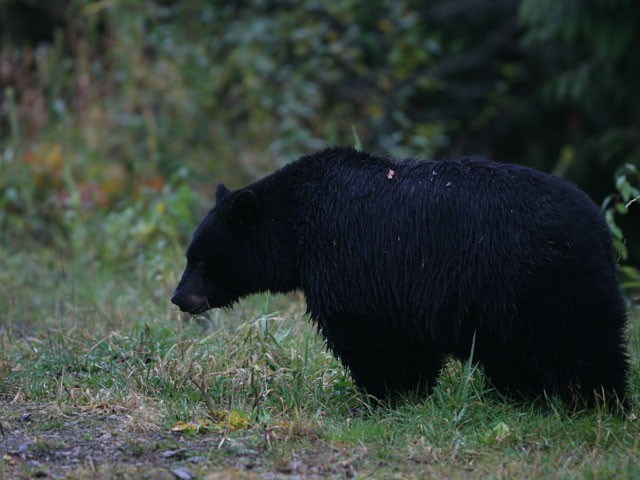During the first week of October the high elevation (1,400-m) berry crop in the ski area depleted to the point where most ski area bears abandoned foraging efforts and reverted back to spring grazing.
Bears were limited to only just over a month of heavy foraging for blueberry, huckleberry, and Sitka-mountain ash berries. The result is visually obvious: most bears are not overly fat this season. I’m seeing more legs than full “u-shaped” bellies.
The cause of the poor berry season was too many rainy, darker days through summer, resulting in excessive berry rot. Plots monitored (during the last decade) recorded mean ripe berry availability at 28 per cent in closed forests, 56 per cent in semi-open forests, and 63 per cent in non-forested berry patches above 1,400 metres elevation.
Fewer berries, means a potential for reduced weight gain for most bears. All cubs are underweight but at different levels and weight gain is certainly relative to the cubs’ physical size. The primary consequence of insufficient weight gain this fall is lower cub production this January and a likelihood of some mortality (’07 cubs and ’06 yearlings) next spring.
Most bears make it through winter but it is the spring period when bears must emerge with reduced weight reserves and feed on vegetation that does not replenish their lost fat stores.
Natural mortality is a part of maintaining a healthy bear population. If cubs or yearlings are brought to rehab centres when otherwise “mother nature” has a specific role for them, this may disrupt the natural cycle of the population and deliver a dangerous mind-set interrupting the success of outreach for people trying to understand how bear populations work. When bears die of natural causes it is better away from people than in our backyards, due to sub-adult dispersal from high density and increased human food-conditioning (both of which occur in Whistler).
This year, 18 known females were observed in the company of 36 offspring: 12 females with 24 cubs and six females with 12 yearlings (cubs born 2006). The bear viewing program monitored 15 of these 18 mothers and their 30 offspring (nine females with 18 cubs and six females with 12 yearlings) in the ski area.
Mean survival rate of ski area cubs was 78 per cent as of Oct. 15. Four cubs were lost (one destroyed in conflict and three missing during June-July breeding period). Of the 12 yearlings that were supposed to be pushed away by/from six mothers during June ’07, four yearlings were allowed to remain with two mothers as of Oct. 15. In 2008, a minimum of five females from the ski area are due to produce cubs depending on the outcome of delayed implantation. Each female is heavier than 160 lbs., a minimum weight I calculated in 2000-04, that females need to produce at least one cub. Overall, 2008 cub production should be lower, which might ease bear numbers since the high production of 50 cubs during 2006-07 (due to bumper berry crops in 2005-06).
Bears are now in the pre-denning period following a poor berry crop, which means most have dropped below snowline to graze new grass and clover while some bears are taking advantage of opportunistic sources of garbage in the valley.
The upside to the large-scale Olympic developments this past spring is that now bears on Whistler Mountain have many newly seeded tracts of ski trails for grazing. Runs are seeded to prevent erosion after construction disturbance. While grasses do little to add to weight gain, white clover does provide potential proteins, especially in younger/smaller bears, that does contribute to lower (than berries) weight gain and maintenance of muscle mass.
Bears have been observed checking denning areas in September and October as they usually want to know their options for denning before November (normal den entrance) and will choose a pre-surveyed den site as the onset to snow begins to cover late season foods.
And bears are tired. I am observing bears taking naps everywhere. Bears have to be very careful to not expend calories with long distance movements or extended periods of activity without caloric gain.
Expect bear activity through into December and possibly January as some bears (if these individuals are still alive) have learned sources of non-natural foods during winter, especially following a poor berry crop.
I conduct bear studies as part of the bear viewing/monitoring program in the Whistler-Blackcomb ski area and to support local/student/visitor outreach of black bear life history.




